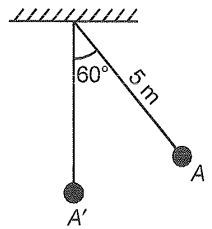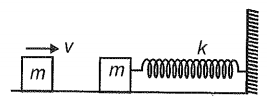Work is done by an agent applying force when
(1) the applied force is variable.
(2) the applied force is perpendicular to the motion.
(3) the applied force generate motion.
(4) the applied force is constant.
A ball is let to fall from a height of 32 m on the ground. The coefficient of restitution is . The height raised by the ball after the second rebound is
(1) 2 m
(2) 4 m
(3) 8 m
(4) 16 m
A bob of a simple pendulum is released from position A. Velocity of the bob when it is at lowest position A is

(1) m/s
(2) 10 m/s
(3) 5 m/s
(4) 2 m/s
A bob is suspended from a peg on a wall by a massless string of length L. If it is given velocity at the lowest point, then angular amplitude with which body will oscillate is
(1) 60°
(2) 90°
(3) 75°
(4) 30°
The ratio of the kinetic energy of a particle projected from the ground at the highest point to point of projection is 1/4. The angle of projection with horizontal is
(1) 30°
(2) 60°
(3) 45°
(4) 53°
A particle of mass m is moving in a circular path of constant radius r such that its centripetal acceleration is varying with time t as ,where k is constant. The power delivered to the particle by the force acting on it is
(1)
(2)
(3)
(4) Zero
A body is under uniform circular motion, its kinetic energy.
1. depends on the direction of velocity.
2. depends on acceleration.
3. remains unchanged.
4. all of these.
Two identical balls of mass 1 kg each moving towards each other with velocities of 3 m/s and 5 m/s respectively. The magnitude of the velocities of respective balls after the perfectly elastic head-on collision is
(1) 3 m/s, 5 m/s
(2) 5 m/s, 3 m/s
(3) 4 m/s, 4 m/s
(4) 6 m/s, 2 m/sIf the two masses are equal

1. \(v\sqrt{\dfrac{m}{k}}\)
2. \(v\sqrt{\dfrac{2m}{k}}\)
3. \(m\sqrt{\dfrac{v}{2k}}\)
4. \(v\sqrt{\dfrac{m}{2k}}\)
1. \(\dfrac{2 um}{m}\)
2. \(\dfrac{2 um}{M}\)
3. \(\dfrac{2 u}{1 + {m \over M}}\)
4. \(\dfrac{2 u}{1 + {M \over m}}\)






